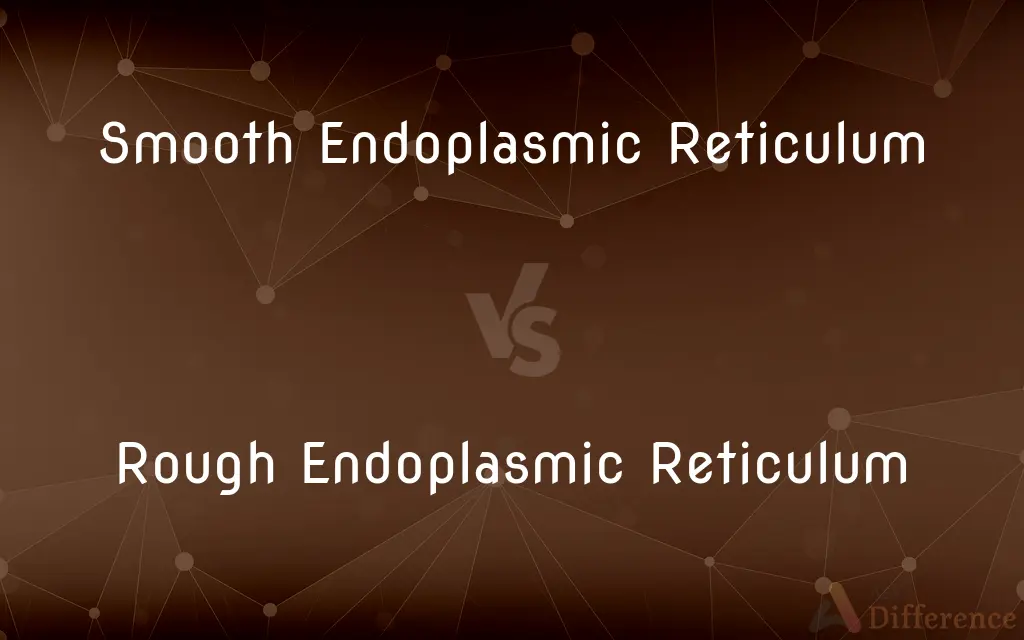Smooth Endoplasmic Reticulum vs. Rough Endoplasmic Reticulum — What's the Difference?
Edited by Tayyaba Rehman — By Fiza Rafique — Published on January 10, 2024
Smooth ER synthesizes lipids and detoxifies chemicals, lacking ribosomes; rough ER, studded with ribosomes, synthesizes and folds proteins.

Difference Between Smooth Endoplasmic Reticulum and Rough Endoplasmic Reticulum
Table of Contents
ADVERTISEMENT
Key Differences
The smooth endoplasmic reticulum (smooth ER) functions as a manufacturing and packaging system. It is crucial in the creation of lipids and hormones, especially in cells that produce these substances for the rest of the body. The rough endoplasmic reticulum (rough ER) is also involved in the synthesis of molecules, but it primarily focuses on the production of proteins that will be secreted from the cell, inserted into the cell’s plasma membrane, or shipped to an organelle.
Smooth ER is characterized by its lack of ribosomes, giving it a smooth appearance under a microscope. It's involved in carbohydrate and lipid metabolism, including the detoxification of drugs and poisons. Rough ER appears pebbled due to ribosomes on its surface. It is integral in the modification and folding of proteins that have been synthesized by the ribosomes.
Cells that engage in a lot of lipid metabolism, such as those in the liver, will have abundant smooth ER. In contrast, cells that synthesize large amounts of protein for export, such as plasma cells, have extensive rough ER. The smooth ER also plays a role in muscle contraction through the release and reabsorption of calcium ions, while rough ER is less involved in this process.
The functions of smooth ER include lipid synthesis, metabolism, and detoxification, which are crucial for liver cells. The rough ER's primary role is to ensure that proteins are properly folded and processed, which is essential for cells that secrete enzymes or antibodies. Both types of ER are interconnected and transition from one to the other, but their functions are distinct and crucial to the cell's operation.
While both types of endoplasmic reticulum are essential components of a cell's architecture and function, their activities are suited to the specific roles they play in cell physiology. The smooth ER and rough ER work together to ensure that the cell can synthesize everything it needs and remove unnecessary or harmful substances, maintaining cellular health.
ADVERTISEMENT
Comparison Chart
Surface Texture
Lacks ribosomes, smooth surface.
Studded with ribosomes, rough surface.
Primary Function
Lipid and hormone synthesis.
Protein synthesis and folding.
Presence in Cells
Abundant in liver and hormone-producing cells.
Abundant in cells producing large amounts of proteins.
Role in Detoxification
Detoxifies drugs and poisons.
Not involved in detoxification.
Calcium Ion Storage
Regulates calcium ion release in muscle cells.
Does not store calcium ions.
Compare with Definitions
Smooth Endoplasmic Reticulum
The smooth ER detoxifies potentially harmful biochemicals.
The smooth endoplasmic reticulum in liver cells detoxifies alcohol.
Rough Endoplasmic Reticulum
Ribosomes are attached to the surface of the rough ER, giving it a rough appearance.
Ribosomes on the rough endoplasmic reticulum synthesize proteins to be exported.
Smooth Endoplasmic Reticulum
In muscle cells, the smooth ER stores and releases calcium ions.
During muscle contraction, calcium is released from the smooth endoplasmic reticulum.
Rough Endoplasmic Reticulum
The rough ER is where protein folding and modification take place.
Improper folding in the rough endoplasmic reticulum can lead to diseases.
Smooth Endoplasmic Reticulum
The smooth ER plays a role in metabolic processes including carbohydrate metabolism.
Enzymes in the smooth endoplasmic reticulum are vital for carbohydrate metabolism.
Rough Endoplasmic Reticulum
The rough ER manufactures membranes for the cell.
The rough endoplasmic reticulum contributes to membrane expansion during cell division.
Smooth Endoplasmic Reticulum
The smooth ER is the cellular site for lipid and steroid hormone synthesis.
Steroid-producing cells have an extensive smooth endoplasmic reticulum.
Rough Endoplasmic Reticulum
Plasma cells have extensive rough ER for antibody production.
The abundant rough endoplasmic reticulum in plasma cells is essential for antibody production.
Smooth Endoplasmic Reticulum
The smooth ER is involved in the metabolism of drugs.
Certain drugs induce the proliferation of the smooth endoplasmic reticulum in cells.
Rough Endoplasmic Reticulum
The rough ER is a membrane factory for the cell, synthesizing proteins.
Secretory proteins are synthesized within the rough endoplasmic reticulum.
Common Curiosities
What is the smooth endoplasmic reticulum?
It's a cell organelle involved in lipid synthesis and detoxification without ribosomes.
What is the rough endoplasmic reticulum?
It's a cell organelle dotted with ribosomes that synthesizes and processes proteins.
What proteins are synthesized by rough ER?
Rough ER synthesizes secretory, membrane-bound, and organelle-targeted proteins.
What happens if the smooth ER is dysfunctional?
It can lead to imbalances in lipid metabolism and reduced detoxification capacity.
Can smooth ER transform into rough ER?
Yes, the ER can transition between smooth and rough states depending on cellular needs.
What is the role of rough ER in immune responses?
It's crucial for the production of antibodies by plasma cells.
How does smooth ER help with detoxification?
It has enzymes that modify potentially harmful compounds to be more water-soluble for excretion.
How do ribosomes attach to the rough ER?
Ribosomes bind to the ER membrane through the ribosome receptor protein.
Does rough ER exist in all cell types?
Rough ER is present in most eukaryotic cells, particularly in protein-secreting cells.
Can mutations affect rough ER function?
Yes, mutations in proteins processed by the rough ER can lead to diseases like cystic fibrosis.
How does the smooth ER contribute to drug tolerance?
It can proliferate and increase enzyme levels, reducing drug effectiveness over time.
Why is the rough ER important for membrane production?
It produces phospholipids and proteins integral to cell and organelle membranes.
What's the relationship between smooth ER and muscle cells?
Smooth ER regulates calcium ions, essential for muscle contraction.
Are there diseases linked to rough ER stress?
Yes, rough ER stress is implicated in conditions like Alzheimer's and diabetes.
What diseases are associated with smooth ER function?
Disorders in lipid metabolism and drug detoxification pathways can arise from smooth ER issues.
Share Your Discovery

Previous Comparison
Active Attacks vs. Passive Attacks
Next Comparison
ACA vs. ACCAAuthor Spotlight
Written by
Fiza RafiqueFiza Rafique is a skilled content writer at AskDifference.com, where she meticulously refines and enhances written pieces. Drawing from her vast editorial expertise, Fiza ensures clarity, accuracy, and precision in every article. Passionate about language, she continually seeks to elevate the quality of content for readers worldwide.
Edited by
Tayyaba RehmanTayyaba Rehman is a distinguished writer, currently serving as a primary contributor to askdifference.com. As a researcher in semantics and etymology, Tayyaba's passion for the complexity of languages and their distinctions has found a perfect home on the platform. Tayyaba delves into the intricacies of language, distinguishing between commonly confused words and phrases, thereby providing clarity for readers worldwide.
















































